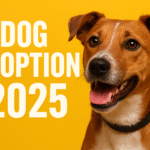In 2025, a surprising trend has taken hold — dog adoption 2025 searches and interest have spiked dramatically. What’s behind this surge? The phenomenon is being called the “Krypto Effect,” named for Superman’s loyal canine sidekick featured prominently in recent media. This wave of enthusiasm offers both opportunity and responsibility for shelters, new pet owners, and content creators alike.
This article explores:
- What data shows about the surge
- Why pop culture can drive real-life adoption
- Best practices for adopting responsibly
- How shelters and rescues can manage spikes
- What content creators and pet businesses should do
- FAQs and action steps for new adopters
The Data Behind Dog Adoption 2025 Surge
Search Trends and Metrics
Following the release of a new Superman film featuring Krypto, searches such as “adopt a dog near me” spiked by as much as 500% in certain regions. Media reports confirm that interest in dog adoption 2025 rose sharply in the weeks following the film’s debut.
Beyond that peak, related queries like “rescue dog adoption near me,” “puppy adoption cost,” and “how to adopt a dog” also showed sustained growth — turning curiosity into genuine intent to adopt.
Shelter Statistics & Adoption Capacity
Nationally, shelter networks and rescue organizations typically handle millions of adoptions every year. In dog adoption 2025 trends, reports indicate that about 1.9 million animals were adopted in the first half of the year in the U.S. alone. Despite the surge in interest, overall adoption numbers have remained relatively stable year-on-year — showing that limits in capacity or adopter readiness still constrain outcomes.
The gap between rising enthusiasm and completed adoptions in the dog adoption 2025 wave suggests several factors at play: limited shelter resources, strict adoption criteria, or potential adopters reconsidering after initial excitement.
Why Pop Culture Sparks Adoption Booms
Emotional Connection & Identification
When audiences encounter a compelling animal character on screen, empathy and emotional identification often shape real-world behavior. Dogs portrayed as loyal, brave, or deeply connected to their owners inspire viewers to seek similar bonds.
In 2025, this emotional pull—fueled by the story of Krypto—has directly influenced the dog adoption 2025 surge. Strategic marketing and heartfelt storytelling amplified the appeal, motivating fans to bring a loyal companion into their own lives.
Visibility & Awareness
Movies and media projects have the power to reach millions instantly. When Krypto started trending across social media platforms, even people who rarely followed pet or rescue topics became part of the conversation. That kind of exposure plays a key role in the dog adoption 2025 surge — it sparks curiosity, spreads awareness, and inspires new audiences to consider giving a dog a forever home.
Risks of Impulse Adoptions
Unfortunately, media-driven adoption spikes can sometimes lead to impulse decisions. New owners may underestimate the long-term time, cost, and emotional commitment. Shelters in previous adoption booms have reported increased returns or surrenders as people realize the responsibilities involved.
So while the surge is a powerful opportunity, it needs guidance and structure.
Guide to Adopting Responsibly in 2025
If you’re exploring dog adoption 2025 or planning to write a helpful guide for new pet parents, these steps will help adopters make informed, responsible decisions. You can also learn from trusted resources like the American Society for the Prevention of Cruelty to Animals (ASPCA), which provides guidance on responsible adoption practices.
1. Self-Assessment before Adoption
- Time commitment: Dogs need regular exercise, socialization, training, and interaction daily.
- Lifestyle alignment: Consider work hours, travel frequency, and living arrangements.
- Financial planning: First-year costs can include vaccinations, microchipping, spaying/neutering, supplies, vet visits, and emergency funds.
2. Research Local Resources
- Identify local shelters, rescues, or foster-based networks.
- Ask about vaccination records, health screening, temperament testing, and history.
- Visit in person and meet multiple dogs to find the best match.
3. Prepare Your Home
- Dog-proof: secure wires, harmful plants, trash cans.
- Set aside a quiet, comfortable space for adjustment.
- Purchase essentials: crate, bed, bowls, leash, collar, toys, and first-aid basics.
4. The Adoption Process & Paperwork
- Fill out adoption applications honestly — shelters often evaluate readiness.
- Be prepared for home visits, reference checks, or adoption fees (which often support shelter operations).
- Ask about post-adoption policies: returns, follow-up support, or training resources.
5. Transition & Training
- Allow at least 72 hours of adjustment without overwhelming expectations.
- Use positive-reinforcement training methods.
- Socialize gradually — exposure to people, pets, environments in a controlled way.
- Consider enrolling in a basic obedience class early on.
6. Long-Term Care & Commitment
- Routine vet check-ups, vaccinations, parasite prevention.
- Quality diet and portion control.
- Dental care, grooming, and exercise tailored to breed/size.
- Plan for emergencies and aging care as the dog grows older.
How Shelters & Rescues Can Handle Adoption Surges
Staggered Processing & Appointments
Instead of open-door surges, require adopters to book appointments or submit applications in windows. This prevents crowding and poor decisions made under pressure.
Pre-Adoption Education
Require or offer short educational modules or handouts explaining responsibilities, costs, and commitment duration. This filters out impulsive or ill-prepared adopters.
Post-Adoption Support
Follow-ups via phone, email, or in-person check-ins can reduce return rates. Offer resources like discounted training, mentorship, or community groups.
Data Tracking & Feedback Loops
Monitor return rates, adoption-to-surrender timelines, and adopter satisfaction. Use that data to adjust application requirements, screening, and education over time.
Strategic Partnerships
Partner with media, local pet supply stores, or influencers to run adoption drives, promote shelter visibility, or waive adoption fees temporarily.
Product & Service Alignment
- Promote starter kits, wellness packages, or training bundles timed for first-time dog owners.
- Offer introductory classes or consults tailored to new adopters.
- Collaborate with local shelters or rescue agencies for promotional events or bundled launches.
Community Engagement
- Use social media to highlight success stories, adoptable pets, or adoption events.
- Encourage user-generated content: adopters posting their journey helps further momentum.
- Be cautious: don’t encourage impulse adoption — always pair excitement with education.
Frequently Asked Questions (FAQ)
Q: Does every spike in search traffic convert to more adoptions?
A: No. Many people browse out of curiosity or idealism. The real conversion depends on shelter capacity, screening, and adopter follow-through.
Q: What’s the average cost of owning a dog in the first year?
A: It can vary widely, but estimates often start from a few hundred to over a thousand dollars, depending on medical care, supplies, and emergencies.
Q: How to choose the right breed or dog?
A: Prioritize temperament, energy level, size compatibility with your living situation, grooming needs, and health history.
Q: What if I can’t commit long term?
A: Consider fostering, volunteering, or supporting shelters instead of full adoption until you’re ready.
What makes dog adoption 2025 different from previous years?
The dog adoption 2025 trend is unique because it’s driven by pop culture influences like the “Krypto Effect,” increased online awareness, and a growing focus on responsible pet ownership. More people are researching adoption before acting, and shelters are improving education and post-adoption support.
If you plan to join the growing dog adoption 2025 movement, begin with an honest self-assessment — note your lifestyle, available time, and the type of dog that fits your home.
Action Steps You Can Take Today
- Visit Local Shelters: Contact nearby shelters or rescue organizations, schedule visits, and have open conversations with staff about breed compatibility and temperament.
- Create Helpful Content: If you manage a pet or lifestyle blog, write practical, SEO-friendly guides that support responsible adoption and include a few relevant internal links.
- For Shelters & Volunteers: Prepare educational materials, adoption checklists, and post-adoption support systems to improve success rates.
- Measure Impact: Track engagement — which guides attract readers, which dogs find homes fastest, and what feedback new adopters share.
Conclusion
The dog adoption 2025 surge — triggered by the Krypto Effect — is more than a fleeting meme. It has real potential to help more animals find loving homes, inspire stronger shelter support, and grow communities built around responsible pet care.
But long-term success depends on balancing excitement with education, guiding adopters wisely, and building better systems to support lasting placements. By applying the best practices shared here — whether you manage a blog, a shelter, or plan to adopt yourself — you can help make the dog adoption 2025 movement a lasting and meaningful change.
For more pet and lifestyle insights, visit KainatTrendScapes to explore guides, tips, and trending topics.











